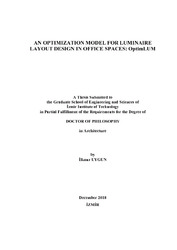Please use this identifier to cite or link to this item:
https://hdl.handle.net/11147/7186Full metadata record
| DC Field | Value | Language |
|---|---|---|
| dc.contributor.advisor | Kazanasmaz, Tuğçe | |
| dc.contributor.advisor | Kale, Serdar | |
| dc.contributor.author | Uygun, İlknur | - |
| dc.date.accessioned | 2019-07-17T07:05:53Z | |
| dc.date.available | 2019-07-17T07:05:53Z | |
| dc.date.issued | 2018-12 | en_US |
| dc.identifier.citation | Uygun, İ.(2018). An optimization model for luminaire layout design in office spaces: OptimLUM. Unpublished doctoral dissertation, Izmir Institute of Technology, Izmir, Turkey | en_US |
| dc.identifier.uri | https://hdl.handle.net/11147/7186 | |
| dc.description | Thesis (Doctoral)--Izmir Institute of Technology, Architecture, Izmir, 2018 | en_US |
| dc.description | Includes bibliographical references (leaves: 104-108) | en_US |
| dc.description | Text in English; Abstract: Turkish and English | en_US |
| dc.description.abstract | There are several methods used in lighting design. The realistic methods have been developed by the computer graphics which use the engineering computational tools and architectural rendering together. Although lighting designers would design an accurate lighting system which provides desired illuminance levels through computer graphics, it is still necessary to propose optimal and alternative solutions by maximizing comfort conditions and minimizing energy consumption by practical techniques. Thus, the purpose of this study is to propose an optimization model for offices to estimate the accurate layout, number and type of light sources according to visual comfort conditions and energy efficiency. Model is conducted mathematically based on the primary objective which is to provide uniform illumination on work plane with the constraints about vertical illuminances and luminance values. Model named OptimLUM is validated by comparing measurements and simulations. Finally, OptimLUM offer some energy efficient layouts for different office sizes with different number and type of light sources. To be more energy efficient and decrease the energy loads by artificial lighting, these layouts were integrated with daylight. Unlike common lighting design solutions, OptimLUM offers unsymmeterical but more energy efficient layouts by using minimum number of luminaires. According to outputs of the model integrated with daylight, for artificial lighting design in offices, lighting designers should decide on the number and type of luminaires by comparing the darkest and day usage conditions. As a result, by using OptimLUM during the design phase, designers can provide visual comfort conditions for office users while reducing the energy loads of artificial lighting. | en_US |
| dc.description.abstract | Aydınlatma tasarımında kullanılan birçok yöntem bulunmaktadır. En yaygın kullanılan ve gerçekçi sonuçlar elde edilebilen bilgisayar yazılımları; mühendislik hesaplama araçları ile mimari üç boyutlu görüntü oluşturma araçlarını bir arada kullanır. Aydınlatma tasarımcıları, bilgisayar yazılımları ile istenilen aydınlık düzeylerini sağlayan doğru aydınlatma sistemleri tasarlayabilmelerine rağmen pratik tekniklerle konfor koşullarını maksimize eden ve enerji verimliliğini en aza indiren optimum ve alternatif çözümler önermelidir. Bu çalışmanın genel amacı, ofislerde ışık kaynaklarının konumunun, sayısının ve türünün en doğru şekliyle tahmin edilebilmesi için bir optimizasyon modeli oluşturmaktır. Matematiksel olarak kurulan modelin ana amacı; çalışma düzleminde eşit dağılımlı bir aydınlık düzeyi sağlamaktır. Ayrıca dikey yüzeylerde aydınlık düzeyi ve parıltı değerleri ile ilgili kısıtlar ile görsel konfor koşullarını sağlamaktadır. OptimLUM ölçüm ve simülasyon sonuçları ile karşılaştırılarak valide edilmiştir. Son olarak, OptimLUM farklı ofis büyüklükleri için faklı sayıda ve tipte armatürle enerji verimli yerleşim düzenleri sunmuştur. Daha enerji verimli olması ve yapay aydınlatmanın enerji yüklerini azaltmak için gün ışığı ile bütünleştirilmiştir. OptimLUM genel aydınlatma tasarımlarının aksine simetrik olmayan ancak daha az sayıda armatür ile daha enerji etkim çözümler sunmaktadır. Modelin gün ışığı ile bütünleştirilmiş sonuçlarına göre, tasarımcılar ofislerde yapay aydınlatma tasarımında, en karanlık ve gün boyu kullanım koşullarının karşılaştırarak armatür sayısı ve türüne karar vermelidir. Sonuç olarak tasarımcılar, tasarım aşamasında OptimLUM kullanarak yapay aydınlatma ile harcanan enerjiyi düşürürken, ofis kullanıcıları için görsel konfor koşullarını sağlayabilirler. | en_US |
| dc.format.extent | xix, 167 leaves | en_US |
| dc.language.iso | en | en_US |
| dc.publisher | Izmir Institute of Technology | en_US |
| dc.rights | info:eu-repo/semantics/openAccess | en_US |
| dc.subject | OptimLUM | en_US |
| dc.subject | Light in architecture | en_US |
| dc.subject | Lighting design | en_US |
| dc.subject | Office buildings | en_US |
| dc.title | An optimization model for luminaire layout design in office spaces: OptimLUM | en_US |
| dc.title.alternative | Ofis mekanlarında aydınlatma aygıtlarının yerleşim tasarımı için bir optimizasyon modeli: OptimLUM | en_US |
| dc.type | Doctoral Thesis | en_US |
| dc.institutionauthor | Uygun, İlknur | - |
| dc.department | Thesis (Doctoral)--İzmir Institute of Technology, Architecture | en_US |
| dc.relation.publicationcategory | Tez | en_US |
| item.languageiso639-1 | en | - |
| item.fulltext | With Fulltext | - |
| item.openairecristype | http://purl.org/coar/resource_type/c_18cf | - |
| item.openairetype | Doctoral Thesis | - |
| item.grantfulltext | open | - |
| item.cerifentitytype | Publications | - |
| Appears in Collections: | Phd Degree / Doktora | |
Files in This Item:
| File | Description | Size | Format | |
|---|---|---|---|---|
| T001866.pdf | DoctoralThesis | 39.35 MB | Adobe PDF |  View/Open |
CORE Recommender
Page view(s)
114
checked on Jul 22, 2024
Download(s)
70
checked on Jul 22, 2024
Google ScholarTM
Check
Items in GCRIS Repository are protected by copyright, with all rights reserved, unless otherwise indicated.